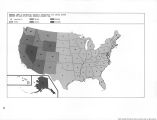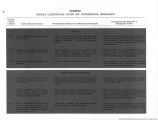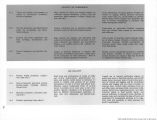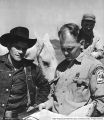| OCR Text |
Show CHAPTER FOURTEEN Tax Immunity BECAUSE OF THE SOVEREIGNTY of the United States, federally owned lands cannot be taxed by state or local governments. This has created large and increasing problems for the states within whose borders such lands lie. The problems are particularly felt in the West where most public lands x are concentrated and where, as previously shown in this report, federally owned lands often constitute a large proportion of a state's total area. But the situation, concerning which the Commission is required to make recommendations, is not confined to the West. Eleven nonwestern states each contain more than 1 million acres of Federal land, ranging from approximately 8 percent of the total area of Arkansas to 3.2 percent of Georgia. In addition, West Virginia contains 920,212 acres of public lands (5.9 percent of the state's total acreage); South Carolina 680,265 acres (3.5 percent); New Hampshire 678,807 acres (11.8 percent); and Vermont 240,238 acres (4.0 percent) (in each state there are also other Federally owned lands). Originally, the Federal ownership of land was considered, in general, to be temporary. Under Federal policy and laws the pubilc domain passed into private ownership and thereupon became subject to state and local taxation. The retention by the Federal Government of comparatively small amounts of land for military or other Federal purposes seemed to pose no serious problem for the future, and even in 1872, when a large tract in Wyoming was set aside to establish Yellowstone National Park, it was still generally assumed that almost all of the rest of the Nation's public domain would eventually be transferred to private ownership. In 1891, however, with passage of the act that authorized the President to set aside forest reservations, a major break with the past occurred. As large tracts of forest land were set aside as reserves, it 1 As used here the term "public lands" refers only to those lands coming within the definition of that term in section 10 of the Commission's Organic Act, as quoted in the Introduction and printed in full in Appendix A. became obvious that millions of acres of the public domain would be retained and managed permanently by the United States and would never pass into private ownership.2 The impact on the taxability of state and local governments by the Federal Government's retention of the forest lands caused concern at an early date, and in 1907 Congress authorized the return of 25 percent of stumpage sale receipts to the counties in which the timber was cut to be used for public education and roads.3 In 1920, the Federal Government acted similarly when the Mineral Leasing Act4 of that year removed from the operation of the Mining Law certain minerals, including oil and gas deposits, and thus assured that lands chiefly valuable for those minerals would remain in Federal ownership. As part of the Mineral Leasing Act, Congress authorized sharing with the states the receipts generated by the oil and gas leases, giving the state of origin 37 Vz percent of the revenue, the Reclamation Fund 51Vi percent, and permitting the United States to keep only 10 percent for its cost of administration. The only exception is that Alaska receives 90 percent of oil and gas lease revenues in accordance with the provisions of the Mineral Leasing Act.5 Several other, but relatively minor revenue-sharing programs were also developed, both before and after the two mentioned above, but payments made by the Federal Government to the states for such programs have been comparatively small.6 2 The 1891 Act, as amended, is 16 U.S.C. §471 (1964). Today the total of lands administered by the Forest Service has grown to over 186.9 million acres in 44 states. Of the total, 160.8 million acres came from public domain lands, and the rest was acquired from non-Federal sources. For a breakdown of acreage by states, see Appendix F. a 16 U.S.C. §500 (1964). 4 30 U.S.C. § 181 et seq. (1964). s 30 U.S.C. § 191 (1964). 6 A breakdown of all programs and payments is contained in EBS Management Consultants, Inc., Revenue Sharing and Payments in Lieu of Taxes, Pt. 2. PLLRC Study Report. 1968. 235 |







































































































































































































































































































































































